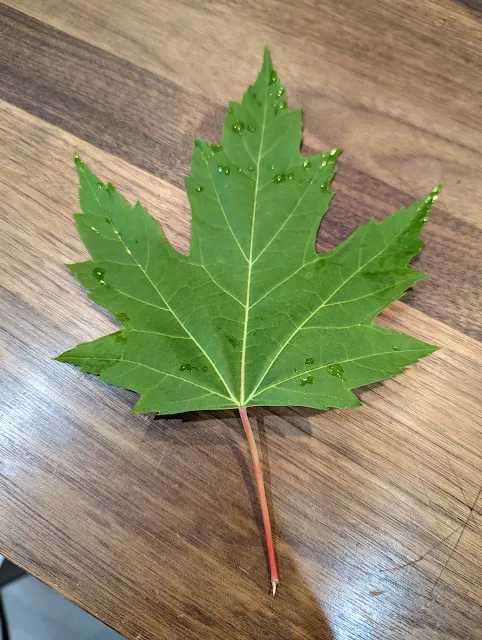Silver Maple Volunteer Tree - Maple Tree Identification - July 2023
Last year, I let this Maple tree volunteer seedling just go. It grew up and up and I ended up protecting it via a chicken wire ring during the Winter. It came back this year and has put on a ton of new growth on the leader. SO....I figured it was time to try to figure out what variety of Maple/Acer I was dealing with in the garden.
I went out and looked the foliage and then started to look around - and it was a quick Web stroll to figure out that I'm dealing with a Silver Maple. Below are two photos of the top and bottom of the leaf - and there are two tells here. At least...I'm about 75% confident that this is, indeed, a Silver Maple.
The silver maple is a North American native and best known for providing us with maple syrup. The leaves have the classic maple leaf shape and become brilliant yellow and red-orange in the fall. Its leaves are deeply lobed with silvery undersides, and its bark becomes shaggy and gray with age.(emphasis, mine)
Over on Arbor Day's site, James R. Fazio writes about the Silver Maple in their "Tree of the Week" feature and describes the paradox around the love/hate relationship of the Silver Maple. He opens his piece with this lede featuring Donald Peattie (who...I now have to 'get to know'):
Silver maples, wrote naturalist Donald Peattie, “impart to every stream and bank where they grow, to every big red Hoosier barn and little white farmhouse, to all the village streets and the long straight roads where they have been planted, an air at once of dignity and lively grace, a combination rare in a tree as in a human.”Mixed feelings, right? Paradox, indeed.
...Silver maples were a staple in many new towns and homesteads on the frontier. Their rapid growth provided quick shade — and they weren’t at all fussy about where they were planted. If there were heroes among trees, silver maples would certainly be candidates for a medal.
But times change. Silver maple has gotten into enough mischief that it is banned as a street tree in some communities. Its offense is that it grows so large, that if planted in a narrow tree lawn or too close to a building, it is inevitable that conflicts with concrete result. Its roots get into trouble too, where space is inadequate, and branches often break under the load of ice or snow. And to someone too old to delight in sticking jumbo seed pods on his nose, well, they are just plain litter.
Silver maple is truly a paradox, but under the right circumstances, its beauty, its spectacular growth rate, and its ability to tolerate poor growing conditions still make it a tree of choice.
This species is native to the Chicago Region according to Swink and Wilhelm’s Plants of the Chicago Region, with updates made according to current research.
So, native to our region. That's...nice. Right?
Now, on the current state of the tree and the growth rate. Below is a photo showing this volunteer seedling in early June. By early-June, the leader had put on 12" of new growth this season:
This is now the tenth tree planted (yes...calling this planted despite it being a volunteer) of the year and 87 overall.
We (now) have 61 of 87 trees that we've planted. 70% success rate over seven years.
87 trees planted/7 growing seasons = 12.42 trees on average planted each season
61 trees alive/7 growing seasons = 8.71 trees on average survive each season.
1. Flowering Pear in backyard on north side.
3. Japanese flowering cherry
4 and 5: 2 Lindens that I espalier'd and placed by the south fence line near our kitchen windows.
7. Nat's Saucer Magnolia in our front yard
2018 (17 planted. 6 Dead):
14, 15, 16, 17, 18, 19, 20, 21. These Frans Fontaine Hornbeams.
22. A replacement Chanticleer Pear tree (3" caliper) out front by our garage
25. Our replanted/replacement Dawn Redwood. Same spot as the first.
26. This teeny-tiny Bald Cypress that I planted in the front yard, in between our driveway and our neighbor to the north.
33. My new Weeping White Spruce that will only grow about 4' wide placed near the fence line alongside the espalier'd Lindens.
35. T
46. A small Northern Red Oak tree - our first Oak tree planted.
47. A 'decapitated' Lavender Twist Weeping Redbud that I planted on a whim.
49. A tall(ish) London Plane tree that suffered some transplant and frost shock, but seemed to recover.







Comments
Post a Comment
Be nice to each other here.